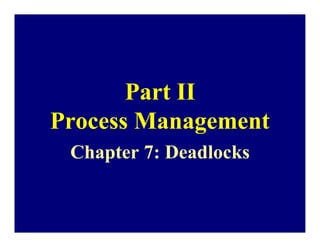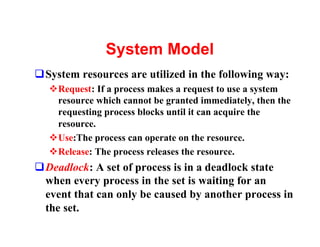This document discusses deadlocks and techniques for handling them. It begins by defining the four necessary conditions for a deadlock to occur: mutual exclusion, hold and wait, no preemption, and circular wait. It then describes three approaches to handling deadlocks: prevention, avoidance, and detection and recovery. Prevention aims to ensure one of the four conditions never holds. Avoidance uses more information to determine if a request could lead to a deadlock. Detection and recovery allows deadlocks but detects and recovers from them after the fact. The document provides examples of different prevention techniques like limiting resource types that can be held, ordering resource types, and preemption. It also explains the banker's algorithm for deadlock avoidance.













![Banker’s Algorithm: 1/2
qThe system has m resource types and n processes.
qEach process must declare its maximum needs.
qThe following arrays are used:
vAvailable[1..m]: one entry for each resource. Available[i]=k
means resource type i has k units available.
vMax[1..n,1..m]: maximum demand of each process.
Max[i,j]=k means process i needs k units of resource j.
vAllocation[1..n,1..m]: resources allocated to each process.
Allocation[i,j]=k means process i is currently allocated k
units of resource j.
vNeed[1..n,1..m]: the remaining resource need of each
process. Need[i,j]=k means process i needs k more units of
resource j.](https://image.slidesharecdn.com/deadlock-120927060722-phpapp01/85/Deadlock-14-320.jpg)
![Banker’s Algorithm: 2/2
qWe will use A[i,*] to indicate the i-th row of
matrix A.
qGiven two arrays A[1..m] and B[1..m], A ≤ B if A[i]
≤ B[i] for all i. Given two matrices A[1..n,1..m]
and B[1..n,1..m], A[i,*] ≤B[i,*] if A[i,j] ≤B[i,j] for
all j.
qWhen a resource request is made by process i, this
algorithm calls the Resource-Request algorithm to
determine if the request can be granted. The
Resource-Request algorithm calls the Safety
Algorithm to determine if a state is safe.](https://image.slidesharecdn.com/deadlock-120927060722-phpapp01/85/Deadlock-15-320.jpg)
![Safety Algorithm
1. Let Work[1..m] and Finish[1..n] be two working
arrays.
2. Work := Available and Finish[i]=FALSE for all i
3. Find an i such that both
v Finish[i] = FALSE // process i is not yet done
v Need[i,*] ≤ Work // its need can be satisfied
If no such i exists, go to Step 5
4. Work = Work + Allocation[i,*] // run it and reclaim
Finish[i] = TRUE // process i completes
go to Step 3
5. If Finish[i] = TRUE for all i, the system is in a
safe state.](https://image.slidesharecdn.com/deadlock-120927060722-phpapp01/85/Deadlock-16-320.jpg)
![Resource-Request Algorithm
1. Let Request[1..n,1..m] be the request matrix. Request[i,j]=k
means process i requests k units of resource j.
2. If Request[i,*]≤Need[i,*], go to Step 3. Otherwise, it is an
error.
3. If Request[i,*]≤Available, go to Step 4. Otherwise, process i
waits.
4. Do the following:
Available = Available – Request[i,*]
Allocation[i,*] = Allocation[i,*]+Request[i,*]
Need[i,*] = Need[i,*] – Request[i,*]
If the result is a safe state (Safety Algorithm), the request is
granted. Otherwise, process i waits and the
resource-allocation tables are restored back to the original.](https://image.slidesharecdn.com/deadlock-120927060722-phpapp01/85/Deadlock-17-320.jpg)
![Example: 1/4
q Consider a system of 5 processes A, B, C, D and E, and 3
resource types (X=10, Y=5, Z=7). At time t0, we have
Allocation Max Need=Max-Alloc Available
X Y Z X Y Z X Y Z X Y Z
A 0 1 0 7 5 3 7 4 3 3 3 2
B 2 0 0 3 2 2 1 2 2
C 3 0 2 9 0 2 6 0 0
D 2 1 1 2 2 2 0 1 1
E 0 0 2 4 3 3 4 3 1
q A safe sequence is <B,D,E,C,A>. Since B’s [1,2,2]≤ Avail’s
[3,3,2], B runs. Then, Avail=[2,0,0]+[3,3,2]=[5,3,2]. D runs
next. After this, Avail=[5,3,2]+[2,1,1]=[7,4,3]. E runs next.
q Avail=[7,4,3]+[0,0,2]=[7,4,5]. Since C’s [6,0,0]≤Avail=[7,4,5], C
runs. After this, Avail=[7,4,5]+[3,0,2]=[10,4,7] and A runs.
q There are other safe sequences: <D,E,B,A,C>, <D,B,A,E,C>, …](https://image.slidesharecdn.com/deadlock-120927060722-phpapp01/85/Deadlock-18-320.jpg)
![Example: 2/4
q Now suppose process B asks for 1 X and 2 Zs. More
precisely, RequestB = [1,0,2]. Is the system still in a safe state
if this request is granted?
q Since RequestB = [1,0,2] ≤ Available = [3,3,2], this request
may be granted as long as the system is safe.
q If this request is actually granted, we have the following:
Allocation Max Need=Max-Alloc Available
X Y Z X Y Z X Y Z X Y Z
A 0 1 0 7 5 3 7 4 3 2 3 0
B 3 0 2 3 2 2 0 2 0
C 3 0 2 9 0 2 6 0 0
D 2 1 1 2 2 2 0 1 1
E 0 0 2 4 3 3 4 3 1
[3,0,2]=[2,0,0]+[1,0,2] [0,2,0]=[1,2,2]-[1,0,2] [2,3,0]=[3,3,2]-[1,0,2]](https://image.slidesharecdn.com/deadlock-120927060722-phpapp01/85/Deadlock-19-320.jpg)
![Example: 3/4
Allocation Max Need=Max-Alloc Available
X Y Z X Y Z X Y Z X Y Z
A 0 1 0 7 5 3 7 4 3 2 3 0
B 3 0 2 3 2 2 0 2 0
C 3 0 2 9 0 2 6 0 0
D 2 1 1 2 2 2 0 1 1
E 0 0 2 4 3 3 4 3 1
qIs the system in a safe state after this allocation?
qYes, because the safety algorithm will provide a
safe sequence <B,D,E,A,C>. Verify it by
yourself.
qTherefore, B’s request of [1,0,2] can safely be
made.](https://image.slidesharecdn.com/deadlock-120927060722-phpapp01/85/Deadlock-20-320.jpg)
![Example: 4/4
Allocation Max Need=Max-Alloc Available
X Y Z X Y Z X Y Z X Y Z
A 0 1 0 7 5 3 7 4 3 2 3 0
B 3 0 2 3 2 2 0 2 0
C 3 0 2 9 0 2 6 0 0
D 2 1 1 2 2 2 0 1 1
E 0 0 2 4 3 3 4 3 1
q After this allocation, E’s request RequestE=[3,3,0]
cannot be granted since RequestE=[3,3,0] ≤[2,3,0] is
false.
q A’s request RequestA=[0,2,0] cannot be granted because
the system will be unsafe.
q If RequestA=[0,2,0] is granted, Available=[2,1,0].
q None of the five processes can finish and the system is
unsafe.](https://image.slidesharecdn.com/deadlock-120927060722-phpapp01/85/Deadlock-21-320.jpg)

![Deadlock Detection Algorithm
1. Let Work[1..m] and Finish[1..n] be two working arrays.
2. Work := Available and Finish[i]=FALSE for all i
3. Find an i such that both
v Finish[i] = FALSE // process i is not yet done
v Request[i,*] ≤ Work // its request can be satisfied
If no such i exists, go to Step 5
4. Work = Work + Allocation[i,*] // run it and reclaim
Finish[i] = TRUE // process i completes
go to Step 3
5. If Finish[i] = TRUE for all i, the system is in a safe state. If
Finish[i] = FALSE, then process Pi is deadlocked.
Use Request here rather than Need in the safety algorithm](https://image.slidesharecdn.com/deadlock-120927060722-phpapp01/85/Deadlock-23-320.jpg)
![Example: 1/2
Allocation Request Available
X Y Z X Y Z X Y Z
A 0 1 0 0 0 0 0 0 0
B 2 0 0 2 0 2
C 3 0 3 0 0 0
D 2 1 1 1 0 0
E 0 0 2 0 0 2
q Suppose maximum available resource is [7,2,6] and the
current state of resource allocation is shown above.
q Is the system deadlocked? No. We can run A first, making
Available=[0,1,0].
q Then, we run C, making Available=[3,1,3]. This is followed
by D, making Available=[5,2,4], and followed by B and E.](https://image.slidesharecdn.com/deadlock-120927060722-phpapp01/85/Deadlock-24-320.jpg)
![Example: 2/2
Allocation Request Available
X Y Z X Y Z X Y Z
A 0 1 0 0 0 0 0 0 0
B 2 0 0 2 0 2
C 3 0 3 0 0 1
D 2 1 1 1 0 0
E 0 0 2 0 0 2
qSuppose C requests for one more resource Z.
qNow, A can run, making Available=[0,1,0].
qHowever, none of B, C, D and E can run.
Therefore, B, C, D and E are deadlocked!](https://image.slidesharecdn.com/deadlock-120927060722-phpapp01/85/Deadlock-25-320.jpg)



